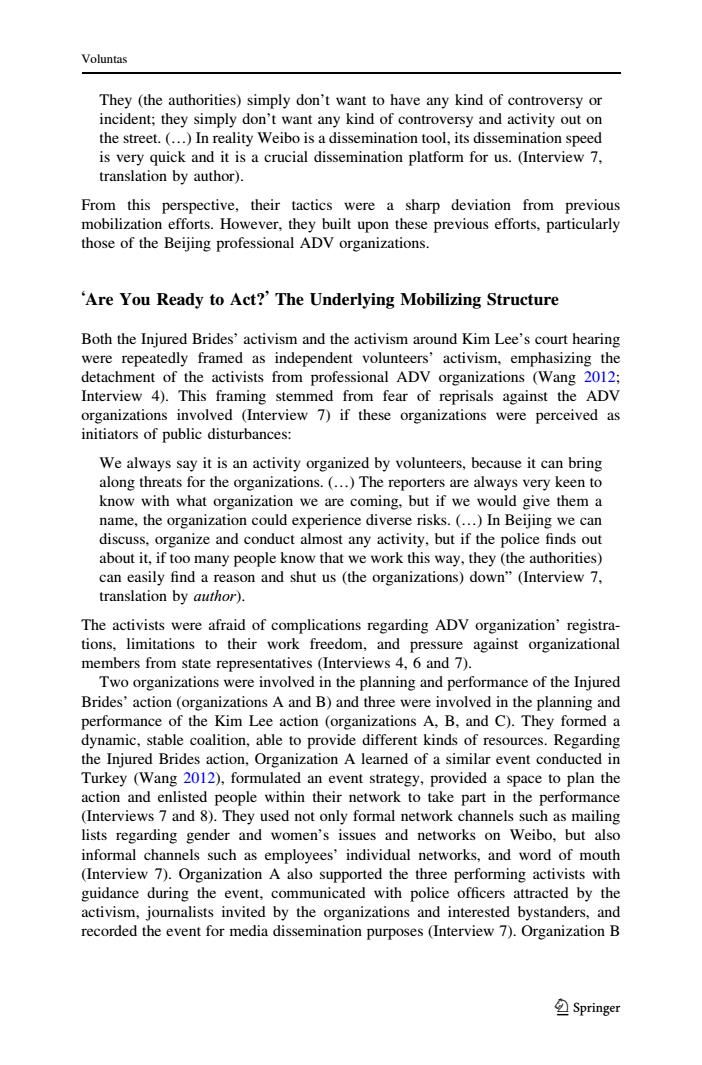正在加载图片...

Voluntas They (the authorities)simply don't want to have any kind of controversy or incident;they simply don't want any kind of controversy and activity out on the street.(...)In reality Weibo is a dissemination tool,its dissemination speed is very quick and it is a crucial dissemination platform for us.(Interview 7, translation by author). From this perspective,their tactics were a sharp deviation from previous mobilization efforts.However,they built upon these previous efforts,particularly those of the Beijing professional ADV organizations. 'Are You Ready to Act?'The Underlying Mobilizing Structure Both the Injured Brides'activism and the activism around Kim Lee's court hearing were repeatedly framed as independent volunteers'activism,emphasizing the detachment of the activists from professional ADV organizations (Wang 2012; Interview 4).This framing stemmed from fear of reprisals against the ADV organizations involved (Interview 7)if these organizations were perceived as initiators of public disturbances: We always say it is an activity organized by volunteers,because it can bring along threats for the organizations.(...)The reporters are always very keen to know with what organization we are coming,but if we would give them a name,the organization could experience diverse risks.(...)In Beijing we can discuss,organize and conduct almost any activity,but if the police finds out about it,if too many people know that we work this way,they (the authorities) can easily find a reason and shut us (the organizations)down"(Interview 7, translation by author). The activists were afraid of complications regarding ADV organization'registra- tions,limitations to their work freedom,and pressure against organizational members from state representatives (Interviews 4,6 and 7). Two organizations were involved in the planning and performance of the Injured Brides'action (organizations A and B)and three were involved in the planning and performance of the Kim Lee action (organizations A,B,and C).They formed a dynamic,stable coalition,able to provide different kinds of resources.Regarding the Injured Brides action,Organization A learned of a similar event conducted in Turkey (Wang 2012),formulated an event strategy,provided a space to plan the action and enlisted people within their network to take part in the performance (Interviews 7 and 8).They used not only formal network channels such as mailing lists regarding gender and women's issues and networks on Weibo,but also informal channels such as employees'individual networks,and word of mouth (Interview 7).Organization A also supported the three performing activists with guidance during the event,communicated with police officers attracted by the activism,journalists invited by the organizations and interested bystanders,and recorded the event for media dissemination purposes (Interview 7).Organization B ②SpringerThey (the authorities) simply don’t want to have any kind of controversy or incident; they simply don’t want any kind of controversy and activity out on the street. (…) In reality Weibo is a dissemination tool, its dissemination speed is very quick and it is a crucial dissemination platform for us. (Interview 7, translation by author). From this perspective, their tactics were a sharp deviation from previous mobilization efforts. However, they built upon these previous efforts, particularly those of the Beijing professional ADV organizations. ‘Are You Ready to Act?’ The Underlying Mobilizing Structure Both the Injured Brides’ activism and the activism around Kim Lee’s court hearing were repeatedly framed as independent volunteers’ activism, emphasizing the detachment of the activists from professional ADV organizations (Wang 2012; Interview 4). This framing stemmed from fear of reprisals against the ADV organizations involved (Interview 7) if these organizations were perceived as initiators of public disturbances: We always say it is an activity organized by volunteers, because it can bring along threats for the organizations. (…) The reporters are always very keen to know with what organization we are coming, but if we would give them a name, the organization could experience diverse risks. (…) In Beijing we can discuss, organize and conduct almost any activity, but if the police finds out about it, if too many people know that we work this way, they (the authorities) can easily find a reason and shut us (the organizations) down” (Interview 7, translation by author). The activists were afraid of complications regarding ADV organization’ registrations, limitations to their work freedom, and pressure against organizational members from state representatives (Interviews 4, 6 and 7). Two organizations were involved in the planning and performance of the Injured Brides’ action (organizations A and B) and three were involved in the planning and performance of the Kim Lee action (organizations A, B, and C). They formed a dynamic, stable coalition, able to provide different kinds of resources. Regarding the Injured Brides action, Organization A learned of a similar event conducted in Turkey (Wang 2012), formulated an event strategy, provided a space to plan the action and enlisted people within their network to take part in the performance (Interviews 7 and 8). They used not only formal network channels such as mailing lists regarding gender and women’s issues and networks on Weibo, but also informal channels such as employees’ individual networks, and word of mouth (Interview 7). Organization A also supported the three performing activists with guidance during the event, communicated with police officers attracted by the activism, journalists invited by the organizations and interested bystanders, and recorded the event for media dissemination purposes (Interview 7). Organization B Voluntas 123